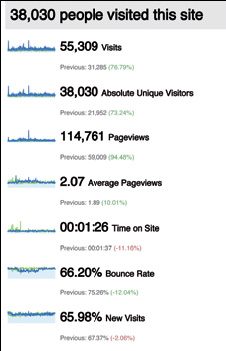The Untold Riches of Rich Media

Too Many Companies are Stuck in the Stone Ages of Analytics.
Most of today’s video technology platforms can produce an amazing array of metrics tracking the extent to which audiences are engaged with the rich media content they consume. Even the most basic solutions can keep tabs on how long viewers watch a specific webcast online, what questions they ask during a live event, and much more.
This type of analytical data can provide keen insight for communicators seeking to better understand how their message connects with their audience. The opportunity for understanding increases exponentially when webcast attendees are identified—either by registration data provided up-front, via the use of online trackers, or via information culled from corporate databases.
For internal webcasts, companies can measure the impact of that participation in specific video events on an employee’s long-term performance. For customer-facing events, sales and marketing staff can differentiate between lukewarm prospects and hot sales leads.
For whatever reason, many organizations deploying video webcasts fail to leverage this available data. Perhaps we can pin the blame on the Corporate Tower of Babel: Video production professionals do not speak the same language as marketing executives and administrators looking for new ways to justify the cost of implementing video more broadly.
As a result, a gold mine of data sits unused. Information on webcast viewership activities that could be woven into a company’s customer relationship management system remains locked in the video management system. Likewise—at some companies, at least—webcast consumption patterns for internal video events are never associated with employee profiles stored in corporate directories. In the process, organizations miss out on prime opportunities to learn about the types of video that produce the biggest business benefit.
Instead, many companies remain mired in the stone ages of streaming video analytics, using the same old standard they use to measure the success of an in-person event: they count how many people are in a room.
A daily selection of features, industry news, and analysis for tech managers. Sign up below.
This is not a bad thing, of course. It’s useful to know how many people attended an online event. But executives are only hurting themselves—and their organization— by not fully capitalizing on the information that can be gleaned using analytics tools that track viewership.
The blunt truth is that not all business video analytics tools are created equal. Some vendors offer solutions that do a better job than others of creating/providing actionable information.
Decision makers considering an investment in a video platform should look carefully at the reporting/ analytics engine within the solutions under consideration. Key features to note include the ability to create new reports and the ease of integration with other platforms (e.g. SharePoint or Salesforce).
Other information on video’s impact can be collected from outside the walls of your corporate network. Specifically, streaming video can have an impact on how your company is featured in search engine results. In general, the more video a company offers on its web site, the better it will perform in search listings. This is particularly the case for organizations that post new videos related to specific search topics on a recurring basis.
The possible strategies for leveraging video viewership data in the business realm are virtually limitless. Indeed, as an industry, the streaming sector stands on the cusp of an era where the viewership information collected from webcasts are more important than the video presented in the event itself.
As a result, your next decision on investing in a streaming media platform should include an array of considerations that go beyond whether a system can handle a specific file format or whether on-screen media players enable custom branding. Now, you have to think about how that system collects, reports, and shares information collected during the webcast itself.
Indeed, it’s not enough that a specific system can track specific viewership behavior. The true value is when the system can package that information in a format that is insightful and easy to interpret. By not leveraging webcast data more effectively, organizations are simply wasting opportunities to learn more about the employees and sales prospects watching their videos.
Steve Vonder Haar is a Senior Analyst at Wainhouse Research and can be reached at svonder@wainhouse.com.
